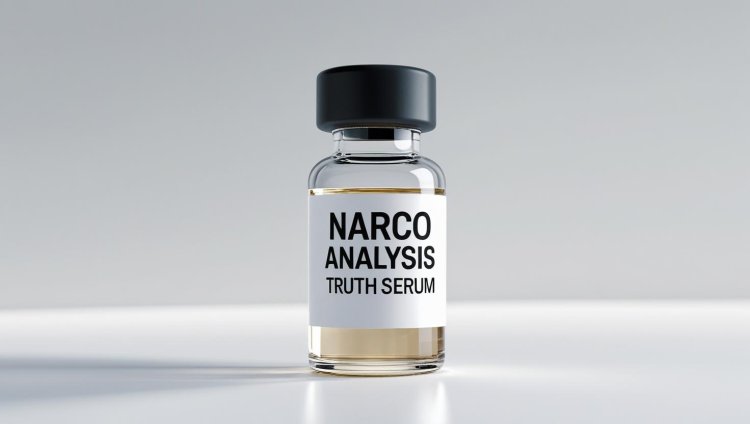"Narco Analysis: A Forensic Tool in Criminal Investigations"
Narco analysis or narco test refers to the practice of administration of barbiturates and certain other chemical substances like - Penthothal sodium. Narco analysis is a psychological investigative method where drugs are used to induce a semi-conscious state in which a person is more likely to reveal information that they may otherwise conceal.

The narco word is derived from NARKC - means Anesthesis. The term is coiled by - Horsely. This technique is used in forenisc physchology for crime or ciminal investigation purpose.
To lower a substance inhibition, hoping that the subject will more freely share information or feelings. Narco Analysis is a forensic psychological technique in which a person is administered certain drugs (commonly sodium pentothal or sodium amytal) that induce a hypnotic or semi-conscious state. In this condition, the subject is believed to be less capable of deliberate lying and may reveal hidden information related to crimes.
Because of this, it is often referred to as a "truth serum test."
HISTORY
1922 Robert house texas obsertrician used the drug scopolamine on to prisoners and it come in mainstream. He observed that women under its influence answered questions without lying, which gave rise to the idea of a "truth serum."
Growth in Forensic Use
-
By the 20th century, narco analysis became part of forensic psychology and criminology.
-
Investigators used it as a tool to extract information when conventional interrogation failed.
-
However, controversies soon arose because:
-
The test was not foolproof.
-
It posed ethical and human rights issues.
-
Courts questioned its scientific reliability.
-
Principle
By using your imagination a person is able to lie. In this test this process is utillised by making him or her semi - conscious. In the state it become difficult to lie and answer restrict to facts already aware for.
-
Drug-Induced Semi-Conscious State
-
Narco analysis works on the principle that certain drugs (commonly sodium pentothal / sodium amytal) depress the central nervous system (CNS).
-
This induces a hypnotic, drowsy, or trance-like state in which the subject’s ability to think critically and fabricate lies is reduced.
-
-
Lowered Inhibitions
-
In this semi-conscious state, the subject’s ego defenses and inhibitions are lowered.
-
The conscious, rational part of the brain that normally filters responses becomes weak.
-
As a result, the subject is more likely to speak freely without much control.
-
-
Spontaneous Responses
-
Since the capacity to lie is suppressed, the person may provide involuntary and spontaneous answers to questions.
-
However, these responses are not always guaranteed to be truthful—imagination, false memories, or confusion can still occur.
-
Teams of expert
- Clinical forensic phychlogist
- Psychiatrist & physician
- Aesthetics
- Audio video grapher
- Writer

Procedure
Pre - Test interview ( Concent is taken )
Pre narcotic state - ( Sodium penthotal is iv 5% or 10% till speech slurred )
Semi narcotic state - ( Slurred speech interview started )
Post test interview - ( Memory checked )
1. Pre-Test Preparation
-
Conducted in a forensic laboratory or hospital with medical backup.
-
A team usually includes:
-
Forensic psychologists
-
Anesthesiologists
-
Investigators
-
Nursing staff & technicians
-
-
The subject’s medical history is checked (to avoid risks like allergies, heart or respiratory problems).
-
Consent of the subject is mandatory (as per the Supreme Court ruling in India, 2010).
2. Administration of the Drug
-
The drug used is usually sodium pentothal (thiopental sodium) or sometimes sodium amytal.
-
It is injected intravenously in a controlled dosage (calculated according to the subject’s sex, age, and health).
-
Dosage is carefully maintained—too little won’t induce the trance, too much may cause unconsciousness or even risk life.
3. Induction of Trance State
-
Within minutes, the subject enters a hypnotic or semi-conscious state.
-
In this state:
-
Inhibitions are lowered
-
Critical thinking reduces
-
Subject becomes more suggestible and may respond without much control.
-
4. Questioning Phase
-
A forensic psychologist or investigator asks questions related to the case.
-
Questions are usually simple and direct to avoid confusion.
-
The responses are:
-
Audio-video recorded for later analysis
-
Observed by experts for psychological cues
-
5. Monitoring
-
Throughout the test, the subject’s blood pressure, pulse, breathing, and brain activity are monitored.
-
Medical experts ensure the dosage does not cross into a dangerous zone.
6. Post-Test
-
Once questioning is complete, the subject is allowed to regain full consciousness.
-
Medical staff keep the person under observation until the drug effects wear off.
-
A detailed report is prepared with transcripts of the answers.
Sodium penthothal - Rapid onset acting barbiturates. It act on GABA (A) reseptor they are inhibitory channel . Barbiturates enhance inhibitory activity
Legal & Ethical Aspects (India)
-
Any statement from narco analysis is not admissible as direct evidence in court, but can be used as investigative leads.
-
Involuntary administration violates Article 20(3) (protection against self-incrimination) and Article 21 (right to life & personal liberty).
Follow cyberdeepakyadav.com on
Facebook, Twitter, LinkedIn, Instagram, and YouTube
What's Your Reaction?
























